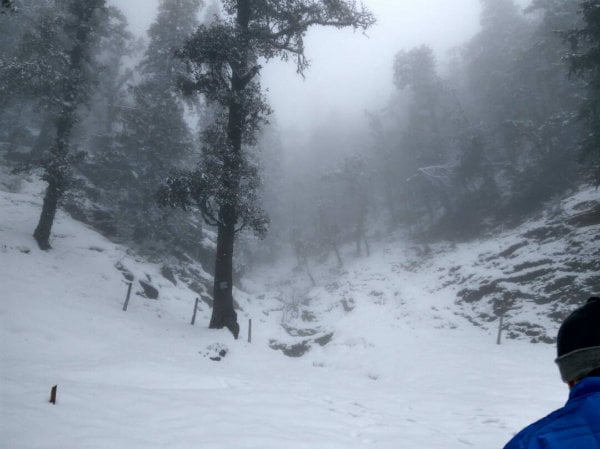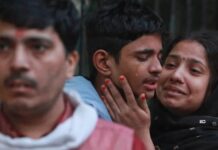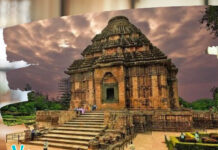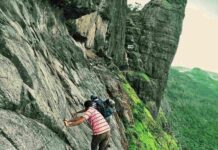I belong to a fairly remote village in Pauri, Uttarakhand.
Naturally, being a pahadi kid, we would always go back to our village any time of the year once a year to check up on our homes left empty after everyone migrated for a better life to places as far as Mumbai or Port Blair.
The village and the forest
Every village has a forest to itself nearby. This has always been a rule since time immemorial.
The upkeep of this forest and the animals dwelling in it are the responsibility of the villagers. And to tell you, villages are better than any forest department. Only after people lost the right over their forests have the mountains been denuded.
Going home
Like any Garhwali person, we had an occasion back at “home”. Despite whatever, we were meant to pack our bags and go to my village.
It was January. The time of snow. Sun was rarely up, and people were seldom seen outside, except a few who went to a nearby town to buy supplies for the month.
The roads were blocked. So my cousins and I decided that we will walk to our village.
The villagers had known about an upcoming snowstorm (which we did not, naturally).
There was no one who we can see, except at the point beyond which cars could not go.
There was fresh snow. My cousins and I knew that another bout of snow rested. The sky was still grey. But we could not have waited for the next day.
The way to home in snow
When we started the trek, it was still fine. The sky was only sprinkling. We decided that we will walk fast and reach the village before it is time. At three or four in the afternoon, darkness starts to set in. It was 12 already.

As we walked, whitescape increased. Snow became deeper. Still, there were footprints so we were relieved. People had walked by there. They seemed an hour stale. But it was enough.
But over some distance, fences were broken. I pointed out to my eldest cousin about the footprints in the snow which were surely of some wild animal.
The mystery of footprints
At first, we postulated that they were of a leopard. If there was a leopard, it would not be a problem because leopards don’t attack a group. Added to that, we had been taught by our grandparents and parents how to keep leopards away.
The road was not very wide. I saw the footprints going to the forest again. We examined them close – front legs are small, hind are bigger. No doubt it was a bear. By this time, there was foot-deep snow. My feet had frozen and it hurt to walk.
Also read: Uttarakhand Burns While The Nation Is Too Busy To Notice
The encounter
People who are not from the mountains have a common misconception that bears hibernate during winters. Not true. Bears become slow. They sleep deeply and for long but they don’t hibernate.
Bears are not intimidated by small groups. They are only scared of large human crowds, like 20-30 people. We were just four.
In fact, when a bear wakes up, he is extremely hungry and sometimes comes close to human habitations. This is why people in the villages often stay in during snow because it is the most likely time to be attacked by wild animals.
The forest through which the road passed became denser. Plus, the wind carried snowflakes so the visibility had considerably decreased. I walked a few meters. And then I heard my cousin growl.

Snow means the deadliest silence you can ever imagine. So much that you doubt the next person can hear you thinking.
I ignored it at first. But then it grew near. I laughed and told my cousin that he should wait till we get to the village if he was hungry. Except, he told me that he heard the same thing. That too thrice. Every time it was closer.
My eldest cousin looked up towards the forest. And there he saw it, over a distance. A blackish, hairy figure, staring right at us. We halted there. What should be done?
We can’t let him come close. We had no weapons with us. The sticks that we had were so frozen that they snapped without effort. We saw it again. The figure was there, translucent with snow. But there for sure.
We decided that we will walk no matter what, and not be afraid. We increased our pace. We couldn’t possibly run with frozen feet and biting winds with backpacks and clothes on.
The figure was still chasing us. This time, it seemed nearer.
We knew what to do when there were bears – run downhill. Bears have small front paws. They can’t run with the same speed downhill as we can because the weight of the body is on its front legs.
But there was fresh snow everywhere. We couldn’t have been sure where our foot would go.
So we decided the one last trick that we could – my eldest cousin told us that bears had ways of attacking you from the hilltop, and it’ll roll down crushing you in its hug while doing so, to the valley.
We stayed as close as we could to the side of the mountain. There was a time when we were clutching the mountain and walking.
The escaping
The forest seemed denser. What to do now?
Everyone was scared. The grunts were still audible. We could not have walked more. So we returned to the place where the roads were blocked. It was a tough decision but we had to make it. The bear walked away as the density of forests reduced and the amount of snow settled.
That was one experience I would never want anyone to go through – it wasn’t just the fear of the known. It was the fear of the unknown too – why was the bear being patient with us? Why hadn’t it attacked us? Is it because there are other bears waiting deep in the forest? Will we be individual hunts?
Snow should never be romanticised. It is the most dangerous time of the year. There have been deaths because of Himalayan brown bears and a few times leopards too. Everything stops at snowtime. There is no help.
Image Credits: Chitra Rawat and Google Images
Other Recommendations:
A Visit To The Paradise On Earth, Remembering Kashmir Through A Picture Story



































